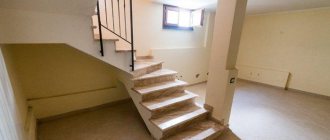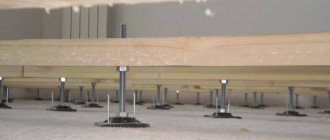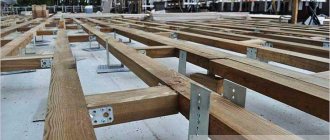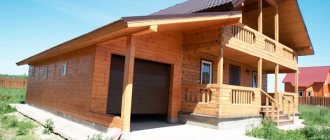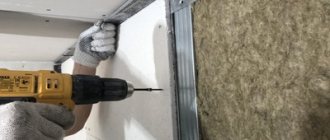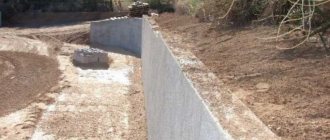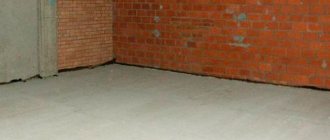When wondering how to glue plywood to a concrete floor, you should not thoughtlessly purchase products that may not justify their service life. In this situation, it is recommended to pay attention to high-quality formulations recommended by experienced users. To get acquainted with the ideal options for fixing, read to the end of today's article. As a result, you will be able to make an informed choice based on these recommendations.
Plywood glued to the floor can be additionally fixed with dowels, as in this photo Source remontnik.ru
Types of glue with a high degree of reliability
Plywood is fixed to the concrete floor in order to level the coating, insulate it and improve performance characteristics. Therefore, it is important that the composition is reliable and does not peel off several months after intensive walking on it. To do this, you need to pay attention to several high-quality layer compositions. They are classified by type.
Polyurethane
Such compositions have increased adhesion and lie securely on the surface the first time. Reliably fix plywood to concrete without the need to use additional fasteners in the form of screws or dowels. Additionally, polyurethane products are divided into subtypes:
- two-component adhesive for plywood on concrete floors. It consists of two parts - an adhesive and a hardener. Using this type of connector, lumber is securely fastened not only to the screed, but also to other types of bases. You need to be able to work competently with such a composition. The fact is that from the moment the mixture is prepared, it must be worked out within 50-60 minutes. Further, it becomes unusable due to the cessation of polymerization properties. Costs more than all other options;
- one-component. A simplified adhesive composition is considered not too plastic, and polymerization occurs in the presence of moisture in the environment where the product will be used. Reliability is not as high as that of the previous modification.
Without exception, all polyurethane adhesives can be diluted using special inorganic or organic solvents. The latter is chosen depending on environmental requirements. That is, for use in residential premises, the product should not have an unpleasant harmful odor, as well as toxins that accompany evaporation when the glue dries.
Gluing plywood onto a concrete floor must be done with gaps Source remontnik.ru
Advantages and disadvantages of plywood flooring
“Planting” sheets on glue is a fairly common method of leveling a concrete floor.
The popularity of this method is due to its advantages:
- this type of work can be easily done with your own hands;
- the material is quite affordable in cost;
- the flooring will become an additional heat and sound insulation layer;
- wood is an environmentally friendly, strong and fairly durable material.
Of course, there are several limitations to the use of sheet plywood, but they are very minor:
- In rooms with high humidity levels, you should use material labeled FSF, and this is not exactly a budget option.
- If the concrete screed has significant differences, it will not be possible to install the flooring using glue: plywood is laid after the base is leveled.
Important! Before starting work, you should check the moisture level of the base. If it is increased, a layer of waterproofing should be laid or the concrete should be treated with a deep penetration primer.
Bitumen mastic can act simultaneously as both a waterproofing and an adhesive mixture
Video description
Adhesives for plywood installation.
Dispersive
The dispersion composition is considered absolutely safe, it is completely odorless. Although the composition is harmless, this negatively affects its strength. It is not able to reliably glue two parts together.
Therefore, we can conclude that this composition is ideal in residential buildings for arranging closets and storage rooms with additional fixation with dowels or steel screws. In general, this product will be ideal for rooms that are least visited.
Dispersion adhesive for gluing plywood to a concrete base can be selected from universal options Source riomaterialy.ru
In what cases is it possible to use plywood when performing finishing work?
Of course, the finished floor can even be made of plywood. Some owners of country houses do just that, treating its surface with paints and varnishes. But more often the purpose of plywood installed on the floor is different.
Today, a number of facing floor coverings are produced, which are quite simply installed on the base. However, the quality of the screed in our houses, especially the evenness of its surface, often does not allow the finishing material to be fixed directly to it. Laying sheets of plywood on the floor to level it is a fairly simple and budget-friendly way out. In some cases, when installing this material, they even refuse to carry out thermal insulation.
Glue brands recommended for use on concrete bases
There are both high-quality and dubious manufacturers of adhesive compositions. And in order not to become a victim of a counterfeit, especially for you, this section contains popular brands of adhesives that can be purchased when deciding how to glue plywood to a screed. These options include:
- IBOLA L12. Glue based on artificial resins. Designed to work with any wood materials. When applied to a concrete screed, no priming is required;
- FORBO 148 Euromix Wood. It is prepared on the basis of polyurethane, is odorless, has sufficient elasticity and good strength, and is also moisture resistant. It is noted that upon complete solidification, the composition becomes chemically inert;
- PARCOL Poly 2K. A two-component original composition that is able to retain its properties for one hour from the moment of preparation. Therefore, it is necessary to quickly use up the prepared mixture. The concrete is first primed and then glue is applied. The finishing coating can be laid only three days after applying the composition to the surface;
- KESTO (KIILT0) Standard. A budget water-dispersion option, the composition is based on Finnish-made PVA. After applying a layer of adhesive to the surface, the plywood must be laid within a maximum of 20 minutes, otherwise the adhesion property will be lost;
- VERMEISTER Repox. An excellent composition from a well-known brand that does not provide any special restrictions on use. Consists of two components, has a polyurethane-epoxy base. Due to its strength properties it is able to withstand various temperature changes.
The adhesives in these photos are universal, but are ideal for gluing plywood to the floor Source kraski-net.ru
Drying speed
Two-component compositions dry the fastest.
When construction and repair work is under tight deadlines, the drying speed of the adhesive is of great importance.
The fastest way (in 1 day) is to glue plywood with two-component compounds, to which a hardener is added before starting work. This method does not require additional fixation of plywood with nails.
Solvent-based compositions dry in 3-5 days. Before applying the glue, you need to prime the screed. Additional fixation with self-tapping screws is required.
Water-based glue dries in up to 7 days. Before application, you can prime the concrete base with a compound diluted with water. Additional fastening of plywood with self-tapping screws is required.
If the screed is not completely dry or there are communications underneath it, it may be necessary to coat the surface with an epoxy-based primer.
Methods for attaching plywood to a concrete base
Gluing sheets of plywood to concrete is carried out in two ways. They are chosen depending on how damaged the screed is and the size of the room. The number of people who will help carry out the installation must also be taken into account. After all, you can’t handle large sheets of paper alone. Laying is carried out:
- fragments of maximum size. Great for leveling floors in simple rooms where there is no geometry. This process is carried out in the shortest possible time, and 3-4 people will be needed to help;
- small square panels. Usually they come with dimensions of 50x50 or 80x80 cm. The plywood sheets are laid out joint to joint. The seams in the rows should be perfectly even. One person can do all the work.
Be sure to thoroughly prime the surface before laying. Otherwise, there is every risk that after some time the plywood will simply peel off from the concrete coating and will walk under the finish.
Preparing the floor for gluing plywood sheets Source remontnik.ru
Laying technology step by step
Installation of plywood on a screed under a parquet board is carried out in six steps. All operations are available for self-production. Minimum set of tools for this:
- markings - ruler, pencil, square, marker;
- cutting - hacksaw, hand-held circular saw, jigsaw;
- installation - spatula-comb with a tooth of 4 - 6 mm, hammer drill, screwdriver, hammer;
- sealing seams - a gun for sealant in tubes;
- finishing - an orbital, belt or vibration sander.
Usually all this tool is available in the arsenal of a home craftsman.
Preparing the base
Before laying plywood, the concrete screed must meet the following parameters:
- unevenness within 2 mm/m²;
- absence of dust, grease stains;
- humidity not higher than 4%;
- no cracks or delamination.
Treating the screed with deep penetration primer.
Before installation, the screed is vacuumed and thoroughly primed; it is advisable to do this the day before installation. When using a spatula with a tooth height of 6 mm to apply glue under the plywood in the following stages, the layer thickness will be a maximum of 3 mm. Therefore, irregularities larger than this size will remain unfilled.
Film screed test for moisture.
Humidity is checked using the standard method - for 12 hours, a piece of plastic film must be secured with tape around the perimeter of the screed for 12 hours. Work can only begin when there is no condensation under the film. Otherwise, the structure needs to be dried naturally additionally. Evenness is checked by the two-meter rule.
Cutting plywood sheets
At the slightest change in humidity in the room, the plywood begins to warp if it is rigidly screwed to the base. Therefore, laying this sheet material on concrete in large pieces is not allowed.
Step-by-step instructions for gluing plywood
When you have chosen how to glue the plywood to the concrete, you can get to work. This should be done according to step-by-step instructions and not to miss important points, which may later lead to deformation of the floor covering. You need to follow the algorithm:
- Prepare the concrete base. Make sure there are no potholes or large cracks. The maximum depth of damage is 2-3 mm. Check whether the screed is damp. To do this, a plastic film is placed over the area for a day, after which the presence of condensation is checked.
- Clean the surface from debris and dust. To do this, it is better to use a powerful construction vacuum cleaner. Here you can calculate the area and buy the required amount of materials. Be sure to have a primer and a sufficient amount of glue. Typically, 10-15% of the bulk may be required for stock.
- Prime the surface. To do this, you need to pour the composition into a convenient container, generously moisten a brush or roller in it and carefully walk over the concrete base. The main thing is not to leave any voids during priming. Once the primer has dried, you need to proceed to the next step.
- Open the container with the adhesive composition, using a mixer or a special attachment on a drill, mix the contents until smooth.
- Pour a certain amount of adhesive onto the concrete screed, level it with a comb spatula, and then carefully press down the sheet of plywood. You need to tap it a little, over the entire area, so that the part completely sticks to the base. You need to start gluing from the far corner and move towards the exit. It is important to leave 3-4 mm compensation gaps between the plywood fragments.
Surface preparation before starting work
Laying of plywood sheets should be done on a level base. This requires a preliminary check of the horizontal level of the floor before starting work. If height differences exceeding 2 mm were noticed, then the screed should be additionally poured or completely re-equipped. Laying should be done after the solution has completely dried, which may take about 45 days. The screed must have a certain level of humidity; to check this characteristic, a polyethylene film should be laid on the floor surface, the minimum size of which is 1x1 m; the material should be pressed well along the edges with heavy objects. After 3 days, the film can be checked for the presence of vapors on its inner surface. If condensation has not formed, then you can begin cutting the plywood and then laying it.
Types of plywood.
Plywood sheets have a disadvantage called internal stress. This may cause the surface of the material to not always be smooth. This feature should be taken into account before starting installation - the material will have to be cut into small pieces of insignificant size, which will allow you to create a flat floor. It is preferable to cut the material into squares with the following dimensions: 0.75 or 0.6 m. The presence of seams between the sheets will compensate for changes in the linear dimensions of the sheets.
Laying plywood should be preceded by an analysis of the condition of the material after cutting.
The canvas must not have any damage in the form of chips or delaminations. After cutting, the sheets can be laid on the surface of the base. Now you can mark the sheets that should be adjusted and adjusted to certain areas of the room, including: niches, corners and protrusions. Rough laying of the material will allow you to create a drawing according to which the final covering of the material will be made.
Related article: Plaster busts for room decoration
Existing plywood sizes.
The laying process must be carried out with the provision of seams, the different types of which should be given a certain width. Thus, between adjacent sheets, the seams should have a width ranging from 0.1 to 1 cm, while between the covering and the wall, the seams should be given a width ranging from 1.5 to 2 cm. Sheets should be numbered before final installation, which will allow position them correctly during the gluing process.
